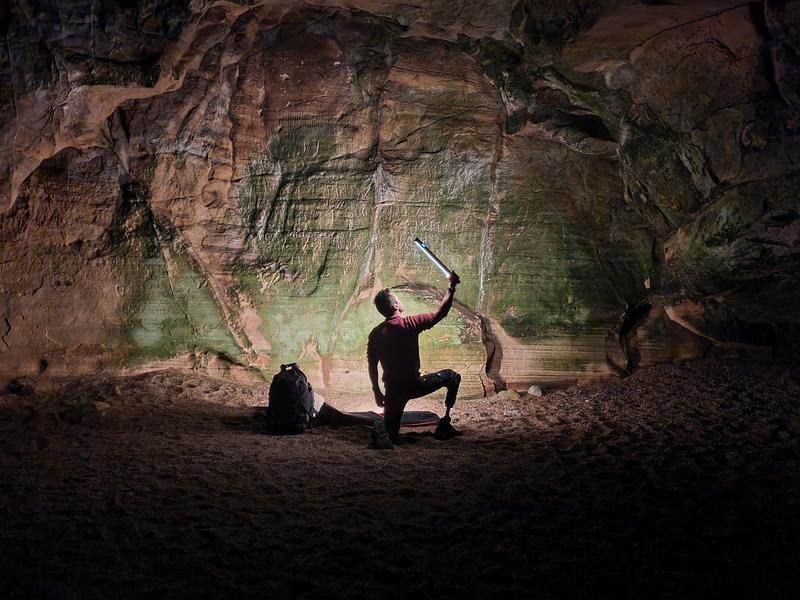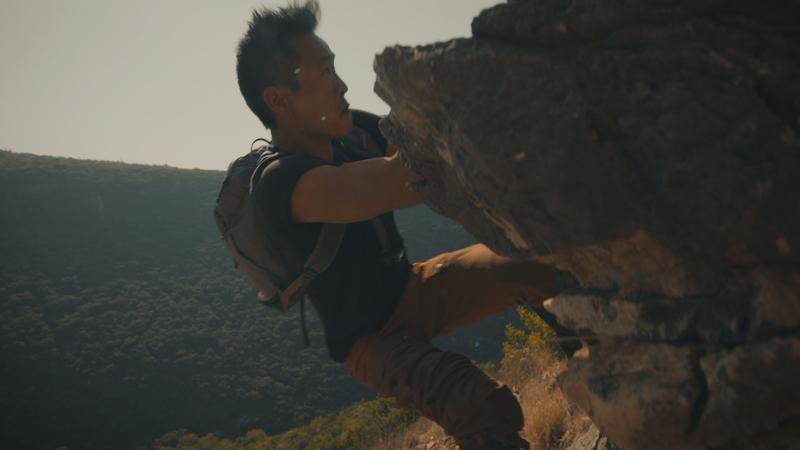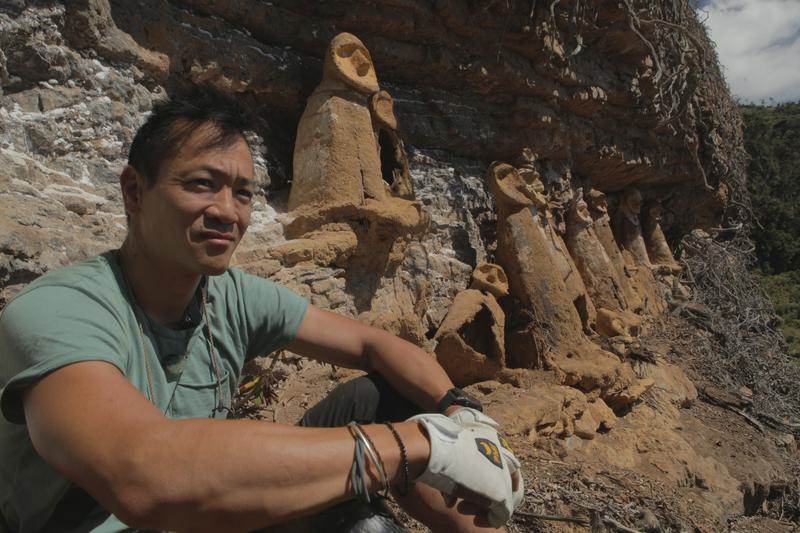High-tech explorer Albert Lin is embarking on six new adventures with National Geographic’s Lost Cities Revealed with Albert Lin. His compass is set for Mexico, Sudan, Peru, Scotland, Oman, and Israel this season. While the adventurer has already been to some of the most famous sites of the ancient world, this season proved to be the most meaningful and most daring. I had the pleasure of speaking with Albert Lin about his most recent adventures ahead of the show’s Thanksgiving premiere.
Benji: Where did your interest in both ancient cities and state-of-the-art technology come from? How did you get to where you are, being able to combine these two passions through your work with National Geographic?
Albert Lin: My origin has a lot of twists and turns, but when I was doing my degrees in engineering in San Diego, I remember thinking to myself, "I don't know if I could just build something as a cog in a wheel." But what I've come to realize is that engineering isn't necessarily about building things. It's about imagining, right? It's about everything you take for granted around you, your chair, or that painting behind you, that was all imagined in someone's mind and then created. And then I found out later that the very essence of discovery has always been driven by that kind of imagination. The first telescope or the first microscope, or even National Geographic as an organization itself, was started by Alexander Graham Bell, the ultimate engineer. So, for me, the story of engineering and exploration go hand-in-hand. But when I was studying, there were a couple of articles that came out, one in particular where this guy had been using satellite imagery to try to look in the invisible spectrum, the infrared spectrum, at ways in which limestone from ancient pyramids was leaching this calcium into the trees and changing their signature. They were going out and finding all these things using that secret treasure map, the invisible. And that just completely blew my mind. So pretty much a year later, I finished my PhD and sold everything I had, I moved into my car, and I wrote this plan of how I was going to search for this tomb in Mongolia using satellites, drones, radar, all these different things. And I took that plan and crowdsourced analytic, and I put it against my wall. I said, "I'm going to commit to this. This is what I'm going to do." And I was literally fresh out of grad school, living out of a car, so everybody thought it was crazy. But the more you say you're going to do something, bit by bit, the more real it becomes. Six months later, I was pitching to the team at Nat Geo this idea, and a year after that, I was in the field, and that's the start of everything. That was the beginning of this long career of exploration for me. And every year after that, I've been just kind of blown away, bit by bit, by how often a moment of discovery can actually be real. I always thought that everything had been figured out, growing up. It's like, all this stuff is in the textbooks, but no, time and time again, we find these things that were hidden in the sands or in the jungles or in the roots of trees that reveal these ancient worlds. And those ancient worlds, they're not some esoteric thing from before. They're literally fingerprints of an experiment in time of how we organized as humans. They're these chapters of us, and each one of them holds this innate wisdom that still resides in us today. It's just sort of lost or forgotten, so I feel like these episodes, they're not just television shows. They're quests. They're like these journeys into the unknown.
Benji: It’s amazing that National Geographic has been around for over a century, yet we’re still uncovering these stories from the ancient past. One of the really cool discoveries is in the episode “Cradle of the Maya” where you discover that before the trees dominated the horizon, the pyramid aligned with the rising of the sun like a calendar.
Albert Lin: Two things have sort of happened. One is, the episode that you're talking about in Mexico where we find what I think is probably one of the origin cities of the Maya, the technology that we use in these shows allow us to reveal things that are completely hidden in the jungles. You can delete the trees, and yet we're hiking around there with machetes, trying to figure out what we're seeing on the ground. But sometimes it takes seeing it from far away, from a distance, where you can see how it all ties together. We've realized in that world in particular, everything is tied around the movement of the sun, everything, and down to the very belief system of human impermanence, of everything. It's like, okay, the sun rises, decays, falls, and then is reborn again in these cycles, and that's in the symbolism all over the Maya world. The other thing is that all of the Maya glyphs, the discovery of the Maya codex and deciphering of the glyphs, that's actually fairly new, and all the information and knowledge that's hidden in those records all just started to bubble up as people are trying to figure out how to decode this stuff, pioneers of this sort of linguistic adventure. That's happening in real-time, so the moment of discovery that we're facing in that world, in particular in the Maya world, is profound, but it's also happening all over the rest of the world. When we were in Peru, and we were using the same technology, the hidden world of the Cloud Warriors, or we are down in Sudan and we're looking in the deserts, and by using radar, we were able to see the lost streets of what we think is a capital city of the Kingdom of Kush, these pyramid builders that took over Egypt and ruled Egypt for a hundred years. You've never even heard of these people, right? But you know that it's more than just buildings and streets and walls. You know that there's some innate human wisdom hidden in those old chapters of us, and if we can go and find those things, we can start to figure out how they organized their world, and maybe we can start to remember stuff that is deeply seated in our human intelligence, in our collective intelligence. That's why it's so profound for me. It's not just like, "Oh, I want to go make these TV shows, or I want to go have these adventures," it's, "Hey, I want to know, what is humanity?"
Benji: As you say, we learn more about humanity through your work, but through the series, we also get to know you. As viewers, we grow to care about you, and there are moments where we fear for you. You had a near miss in one of your episodes, where we may not be talking today if one thing moved a couple of inches way or the other. How do you deal with those moments of peril?
Albert Lin: That was rough. I was on a cliff. We were hiking. We were trying to get to the top of a cliff to look down and see if we could find a lookout tower of the ancient Canaanites. Their story is a story of resilience, and this moment was probably one of two moments in my life where everything really did truly slow down. I pulled myself up on this cliff. It'd just been pouring rain, so this huge limestone boulder that I was on, I thought it was solid. But all of a sudden, the world around me and that boulder started to move, and I could feel myself falling back on the cliff, hugging this massive stone. Then, I don't know how, but I threw myself in as far as I could to the side of this boulder as it was falling, and I was just waiting for it to crush me. I'm like, "When is it going to happen? What's going to happen?" A lot of things flash before your eyes when you think you're about to get demolished, and it's happened to me before. I've been crushed before, and I know that feeling, and it's intense. You start to think about all the things that you wished you could still do. For me, I always think about my kids. It's like, "Oh, my God. I don't want to let that go." But when that boulder came down, and I started looking around, and I wasn't bleeding, I was like, "Oh, thank goodness." But as I went to stand up, all of a sudden, I got nothing to stand on. I mean, what? I look down. It's me, it's the boulder, and then my foot is on the other side of it. And my foot, which is made of titanium because I've already had this happen to me before, is gone. It's just gone. I was like, "What?" So now, it's a good cocktail story. It's like, "Hey, I'm the only amputee you know who lost his leg twice." But in the moment, oh, it was so visceral, so real, I was shaking.
Benji: It's a weird blessing in a way that it happened to something that you can reconstruct.
Albert Lin: What you don't see, the reason why the camera whips away, is that a big boulder landed on the ground, cracked, bounced off, and it broke two ribs of my cameraman. And he didn't tell us about it until days later. He was so tough. We've had multiple moments like that. We had a river accident in the headwaters of the Amazon where we lost all our cameras, and three guys almost drowned. We were tear-gassed, flash-bombed, and arrested in Sudan right before the coup came out. I mean, these places, they're the frontier. You go out in the world, and things can happen. But each one of the quests, they're meaningful. If this was just some entertainment piece, I don't know if I'd put myself repeatedly in these moments of danger. When you show somebody on the ground the discovery that you've just made in the lands of their ancestors, like when we were up in the mountains of the Cloud Forest and we find all these sarcophagi hidden on these cliffs of the ancient Cloud Warriors, and we came down, and we showed the village that had been stewards of this place what we had discovered, people were in tears. They were climbing on the rafters. They were looking into our data and seeing a mirror into their own story, and for me, that makes all of this worth it. These stories are shared, not just by the people that live there but also by us. Every single one of those human experiments into who we are, those cities, those civilizations, the communities that we've created through time, and then that have disappeared in either conflict or natural disaster. Those experiments live within us. They're a part of us. We just forgot them. We forgot the wisdom in them, so every time we go and make one of these discoveries, I feel like I'm putting back together the pages of a big book, the lost pages of the story of us.
Benji: Well, thank you very much for your time and your important work. I know the show's entertainment value is somewhat incidental, but we really enjoy it and look forward to seeing more new episodes on National Geographic and Disney+.
Albert Lin: I hope you do, too. I know the first episodes get aired nationally on Thanksgiving night. So, after you've had your turkey and you've eaten all the good food, sit back and go on a grand adventure. And then a week later, everything streams on Disney+ and Hulu, so whether you get it after your turkey or you get it a week later, I hope you get your adventure into the world. These last few episodes, they've changed my understanding of the world, and I'm grateful for them. And we put our blood, sweat, and tears into them, and they're the greatest adventures I've ever had, so thank you.
Don’t miss Lost Cities Revealed with Albert Lin premiering Thursday, November 23rd, at 9/8c on National Geographic. New episodes will air that same night and time through December 21st, but Disney+ and Hulu subscribers can stream the entire season beginning Wednesday, November 29th.





